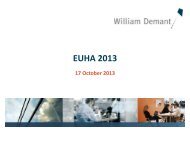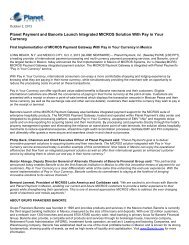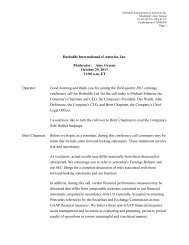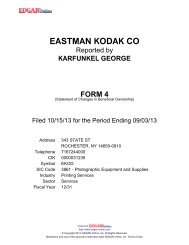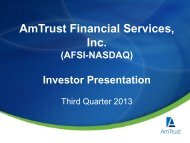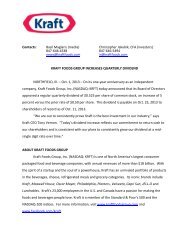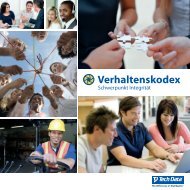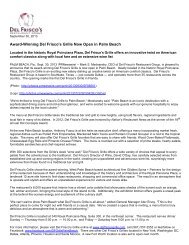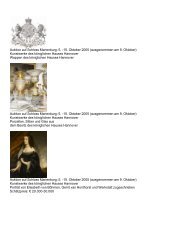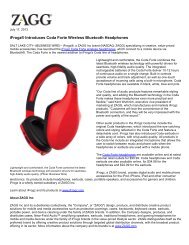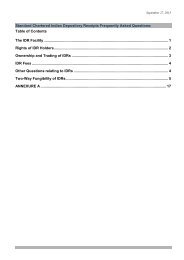Hypercom Corporation Annual Report - CiteSeer
Hypercom Corporation Annual Report - CiteSeer
Hypercom Corporation Annual Report - CiteSeer
Create successful ePaper yourself
Turn your PDF publications into a flip-book with our unique Google optimized e-Paper software.
The Company revised the estimated useful lives of property, plant and equipment acquired through business acquisitions to<br />
conform with its policies regarding property, plant and equipment. Depreciation is provided over the estimated useful lives of the<br />
assets using the straight-line method. The estimated useful lives of the Company’s property and equipment are as follows:<br />
Building 30 years<br />
Computer equipment and software 1 - 5 years<br />
Machinery and equipment 2 - 7 years<br />
Equipment leased to customers 2 - 5 years<br />
Furniture and fixtures 2 - 7 years<br />
Leasehold improvements are amortized over the shorter of the lease term or the life of the asset.<br />
Capitalized Software Development Costs<br />
The Company capitalizes certain internal and external expenses related to developing computer software used in the products it<br />
sells. Costs incurred prior to the establishment of technological feasibility are charged to research and development expense. The<br />
Company considers technological feasibility to have been established for a product when all of the following conditions have been<br />
met: (a) the detail program design has been completed and it has been determined that the necessary skills, hardware, and software<br />
technology are available to produce the product; (b) the detail program design has been traced to product specifications; and (c) all<br />
high-risk development issues have been resolved through coding and testing. Upon general release to customers of the product in<br />
which the software is included, capitalization ceases, and such costs are amortized using the straight-line method over an estimated<br />
life of one to three years. The amounts capitalized in the years ended December 31, 2009, 2008 and 2007, were $1.1 million,<br />
$0.1 million and $1.4 million, respectively.<br />
Impairment of Long-Lived Assets<br />
The Company assesses the potential impairment of long-lived assets when events or changes in circumstances indicate that the<br />
carrying value of the assets may not be recoverable. Factors that the Company considers in deciding when to perform an impairment<br />
review include significant under-performance of a product line in relation to expectations, significant negative industry or economic<br />
trends, and significant changes or planned changes in the Company’s use of the assets. Recoverability of assets that will continue to be<br />
used in the Company’s operations is measured by comparing the carrying amount of the asset grouping to the Company’s estimate of<br />
the related total future net cash flows. If an asset carrying value is not recoverable through the related cash flows, the asset is<br />
considered to be impaired. The impairment is measured by the difference between the asset grouping’s carrying amount and its fair<br />
value, based on the best information available, including market prices or discounted cash flow analysis. If the assets determined to be<br />
impaired are to be held and used, the Company recognizes an impairment loss through a charge to operating results to the extent the<br />
present value of anticipated net cash flows attributable to the asset are less than the asset’s carrying value. When it is determined that<br />
the useful lives of assets are shorter than originally estimated, and there are sufficient cash flows to support the carrying value of the<br />
assets, the Company will accelerate the rate of amortization charges in order to fully amortize the assets over their new shorter useful<br />
lives. This process requires the use of estimates and assumptions, which are subject to a high degree of judgment. If these assumptions<br />
change in the future, the Company may be required to record impairment charges for these assets. For the years ended December 31,<br />
2009, 2008 and 2007, long lived asset impairment charges totaled zero, $8.8 million and zero, respectively. There can be no assurance<br />
that future long-lived asset impairment tests will not result in a charge to earnings.<br />
Goodwill<br />
Goodwill is recorded when the purchase price paid for an acquisition exceeds the estimated fair value of the net identified<br />
tangible and intangible assets acquired. The Company is required to perform an impairment assessment at least annually on December<br />
31, and more frequently under certain circumstances. If the Company determines through the impairment process that goodwill has<br />
been impaired, the Company will record the impairment charge in the statement of operations. For the years ended December 31,<br />
2009, 2008 and 2007, goodwill impairment charges totaled zero, $59.0 million and zero, respectively. There can be no assurance that<br />
future goodwill impairment tests will not result in a charge to earnings.<br />
Discontinued Operations<br />
The Company analyzes its operations that have been divested or classified as held-for-sale in order to determine if they qualify<br />
for discontinued operations accounting. Only operations that qualify as a component of an entity can be included in discontinued<br />
operations. In addition, only components where the Company does not have significant continuing involvement with the divested<br />
operations would qualify as a discontinued operation. Continuing involvement would include the Company continuing to exert<br />
significant influence or continue to have contractually obligated run-off operations related to the operations it is divesting. See Note 6<br />
and Note 11 for further discussion.<br />
- 56 -



